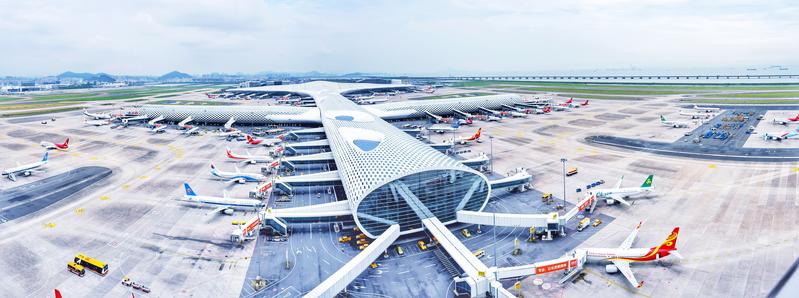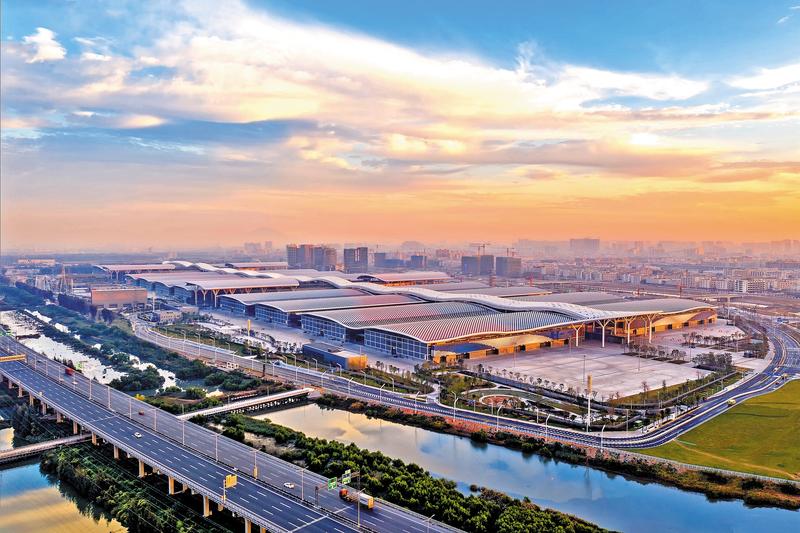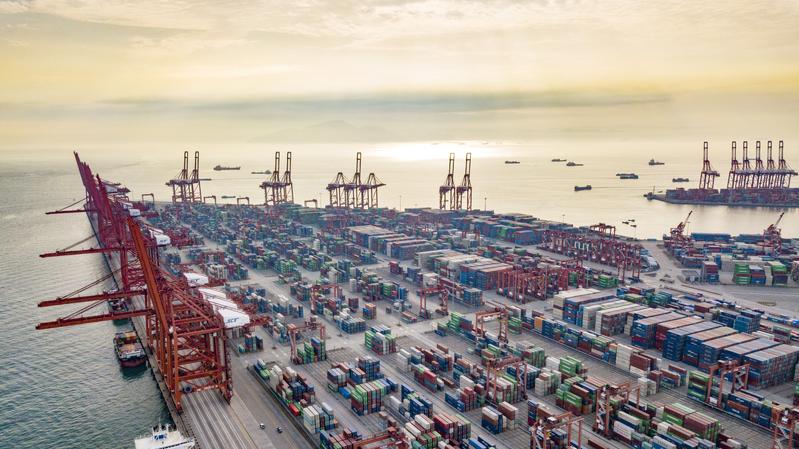Shenzhen zone urged to pursue new ties, policy synergy with HK to boost modern service sectors
 A panoramic view of Qianhai. (PHOTO PROVIDED TO CHINA DAILY)
A panoramic view of Qianhai. (PHOTO PROVIDED TO CHINA DAILY)
Economic pundits believe it is time for the Qianhai Shenzhen-Hong Kong Modern Service Industry Cooperation Zone to study the possibilities of further breaking geographical and administrative limitations and establish a new cooperation model of “designing policies jointly, developing synergistically and sharing achievements together” with Hong Kong.
They made the suggestions one year after the State Council (China’s Cabinet) released the “Plan for Comprehensive Deepening Reform and Opening Up of the Qianhai Shenzhen-Hong Kong Modern Service Industry Cooperation Zone”.
The Qianhai plan, released in September 2021, has offered greater opportunities for Hong Kong firms, professionals and startups, with more interconnecting measures and platforms launched recently.
A key decision of the Qianhai plan is to expand the zone’s area by about eightfold — from 14.92 square kilometers to 120.56 square kilometers. The move not only provides Qianhai with more development space, but also gives the zone a fresh impetus to diversify its industries, experts said.
The areas covered in the expansion include the Shenzhen World Exhibition & Convention Center, Shenzhen Baoan International Airport, the business center of Baoan district, and the Shekou Industrial Zone.
“Industries of Qianhai are more comprehensive after the expansion. They cover medical services, exhibitions, manufacturing, marine and aviation,” said Wilson Pang, vice-president of the Hong Kong Chamber of Commerce in Qianhai.
The good news for investors from the Hong Kong Special Administrative Region is that they will be offered one-third of the enlarged space to operate in. “Our members from the modern-services industry are excited about this development as they expect their client base to expand by leaps and bounds in the new zone,” Pang said.
“Other members from emerging sectors, such as medical services and new energy, also believe they will have more space to meet increased demand for their services. Some fields, like the marine economy, are relatively new to Hong Kong. So it could also help us consider how to transform our traditional advantage industries like financial and logistics services to integrate with these emerging industries.”
 Shenzhen Baoan International Airport, which is covered in Qianhai’s expansion plan. (PHOTO PROVIDED TO CHINA DAILY)
Shenzhen Baoan International Airport, which is covered in Qianhai’s expansion plan. (PHOTO PROVIDED TO CHINA DAILY)
In 2021, the number of Hong Kong-invested enterprises in Qianhai surged 156 percent year-on-year, while the actual use of Hong Kong assets reached $5.42 billion — up 23 percent compared with the previous year. The Qianhai plan also supports technology development in the zone, focusing on artificial intelligence, healthcare, financial technology and new materials. It aims to improve services facilities in the entire industry chain, including high-end talent centers, venture capital funds and incubators.
The Qianhai Shenzhen-Hong Kong Youth Innovation and Entrepreneur Hub began operating in 2014, originally occupying 58,000 square meters. In July, the facility opened up a further 92,000 square meters for young entrepreneurs, especially those from the Hong Kong and Macao special administrative regions. So far, more than 600 startup teams, including 331 from Hong Kong, have been incubated at the e-hub.
Zhou Fei, an MBA graduate from the Hong Kong University of Science and Technology, took his startup, BMTek Inc, to the e-hub in 2017. Within six years, the number of his employees has grown from a dozen to about 150, and he plans to hire 100 Hong Kong professionals in the future as the company prepares to explore overseas markets.
Zhou and his team have spent years developing AI-empowered machine-vision technologies that have been dominated by foreign enterprises. Compared with foreign offerings, his product can cut the cost of such technologies by half.
The Qianhai plan also aims to further open up the legal services sector and encourage more Hong Kong law firms to operate in the zone. Two Hong Kong lawyers in Qianhai were licensed to practice in the nine mainland cities of the Guangdong-Hong Kong Macao Greater Bay Area last month. They can now represent residents in those cities.
William Ng Lok-ming, a Hong Kong lawyer who was granted a license to practice in Qianhai, said the zone’s robust development and its “relatively familiar” atmosphere are the most important factors in his decision to choose Qianhai for his business. He expects the volume of legal services in Qianhai to go up in the near future.
Qianhai initiated a Shenzhen-Hong Kong international legal services center in January. The center has so far gathered more than 120 international institutions of justice, arbitration, mediation, legal services and intellectual property protection. In May, it promulgated a measure to hand out rewards of 200,000 yuan ($28,600) to law firms that employ more than 30 Hong Kong or Macao legal practitioners.
 The Shenzhen World Exhibition & Convention Center, which is covered in Qianhai’s expansion plan. (PHOTO PROVIDED TO CHINA DAILY)
The Shenzhen World Exhibition & Convention Center, which is covered in Qianhai’s expansion plan. (PHOTO PROVIDED TO CHINA DAILY)
Qianhai is not the only economic development zone in the country that enjoys favorable policies. The State Council in June initiated a new development plan for Guangzhou’s Nansha district — another key area for Guangdong-Hong Kong cooperation.
Although the plan came almost a year after Qianhai’s, the Nansha model proposes a similar format for the legal sector, and the first batch of GBA lawyers’ licenses in Guangdong province was issued to lawyers in Nansha.
Hong Kong and Macao residents working in the district will also be eligible for partial exemption from personal income taxes that exceed those in the two SARs. This is one of Qianhai’s most-significant and pragmatic preferential policies to attract Hong Kong professionals, but now it is no longer an attraction unique to Qianhai.
The Hong Kong University of Science and Technology (Guangzhou), meanwhile, officially started its first semester this month. The institution is expected to act as a bridge for in-depth scientific cooperation with local governments and firms.
“Competition is common among economically developed areas, including top-level design and preferential policies,” said Eddie Yan, a partner in government and public services and leader of the Free Trade Zone Services Center at Deloitte China. Facing these challenges, the Qianhai zone should concentrate more on the modern-services sector, such as research and development, the digital economy and modern logistics, and should have more “differentiation advantages with Qianhai characteristics”, he said.
“It’s also necessary to explore further possibilities of linking up the different cross-border mechanisms and taking the lead in providing a wider and closer integration method,” Yan said. “Many of the measures launched in the first year of the Qianhai plan are aimed at breaking down barriers. The ‘Qianhai 2.0’ era is now taking shape, with more and more sharing and connecting platforms established recently. These platforms have laid a solid foundation for an interconnected Qianhai 3.0.”
Xiao Geng, director of the Institute of Policy and Practice at the Shenzhen Finance Institute, would like to see Qianhai introduce a new model of “dual headquarters” together with the HKSAR government.
 Shekou Container Terminals, which is covered in Qianhai’s expansion plan. (PHOTO PROVIDED TO CHINA DAILY)
Shekou Container Terminals, which is covered in Qianhai’s expansion plan. (PHOTO PROVIDED TO CHINA DAILY)
Under this model, eligible firms registered and based in Hong Kong can set up a secondary operating base in Qianhai, but their offshore businesses in Hong Kong and Qianhai should continue to be regulated and supervised by the Hong Kong authorities. The tax and GDP contributions of these “dual headquarters” firms can be shared between the authorities on both sides, Xiao said.
Such a plan could help ease the restrictions involved as overseas firms would become mainland market entities once they are registered in Qianhai and would have to abide by foreign-exchange regulations under the mainland system, he said.
Xiao also suggested that mainland firms offering onshore services in Qianhai be allowed to set up secondary headquarters in a pilot zone in Hong Kong to develop overseas markets. The new model could upgrade cooperation between the two sides to a new partnership that will complement each other and achieve a win-win outcome, he said.
The Qianhai authority told China Daily that it is studying a new management system that could “moderately separate administrative regions and economic regions”. It may also proactively align with Hong Kong’s development strategy for the SAR’s Northern Metropolis project and consider “designing policies jointly, developing synergistically and sharing achievements together in a designated zone with Hong Kong”.
In fact, attempts have already been made in this direction. Fu Zhengping, president of the Institute of Free Trade Zones at Sun Yat-sen University, referred to the 18 supporting measures provided in “a joint policy package” announced by Hong Kong’s Financial Services and the Treasury Bureau and the Qianhai authority on Sept 2.
“It’s the first time both sides have consolidated their policies in the form of a joint announcement,” he said, adding that it represents a groundbreaking move in Shenzhen-Hong Kong cooperation.
According to a report published by the Institute of Free Trade Zones in July, Qianhai, as part of the Guangdong Free Trade Zone, topped the rankings in the institutional innovation index among all free trade zones in the country. “Compared with its performance last year, Qianhai stands out in the upgrading of government services and the legal environment this year,” Fu said.
The Qianhai authority has said that it has launched 685 innovation measures since its inception in 2010, with 65 of these replicated and promoted nationwide.



